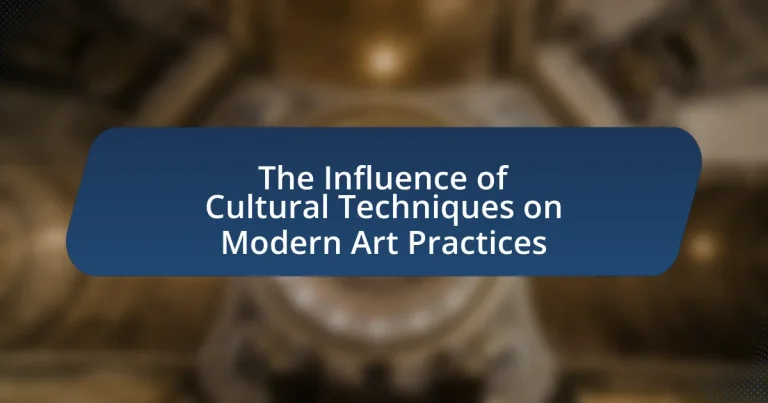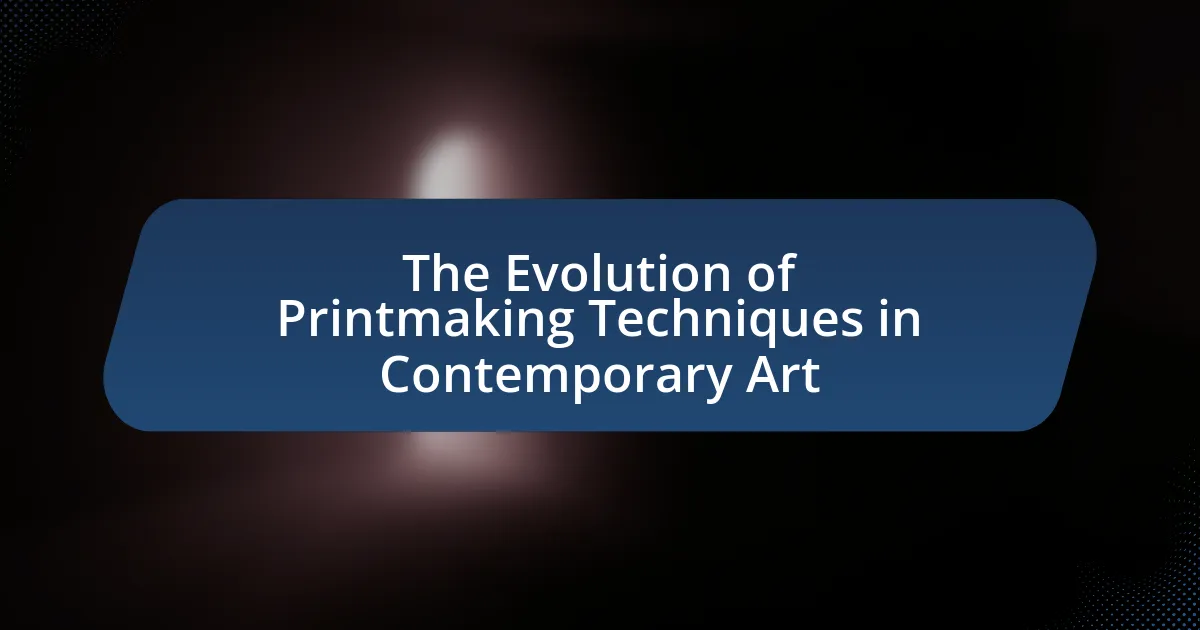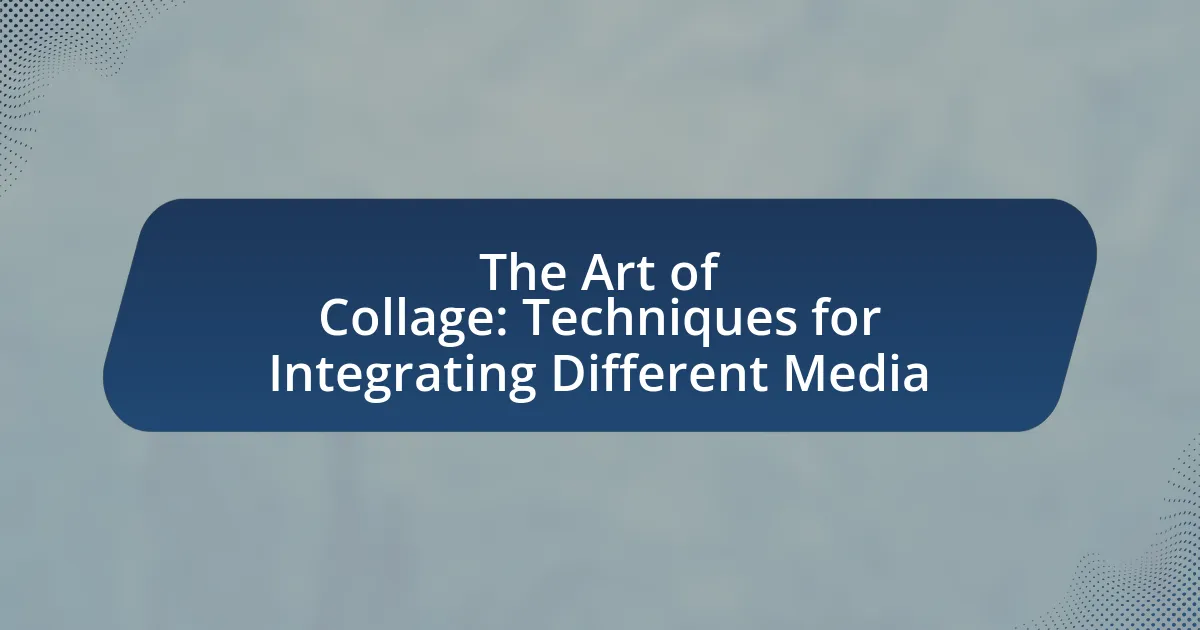Cultural techniques encompass the methods and practices through which societies create, share, and interpret art, significantly influencing artistic expression and audience engagement. This article explores the evolution of cultural techniques in modern art, highlighting their impact on artistic practices, the integration of technology, and the importance of cultural context. It examines how specific techniques, such as abstraction and performance art, have shaped contemporary movements and discusses the challenges artists face in incorporating diverse cultural practices. Additionally, the article emphasizes the role of globalization and technology in redefining artistic expression and fostering collaboration among artists from various backgrounds.
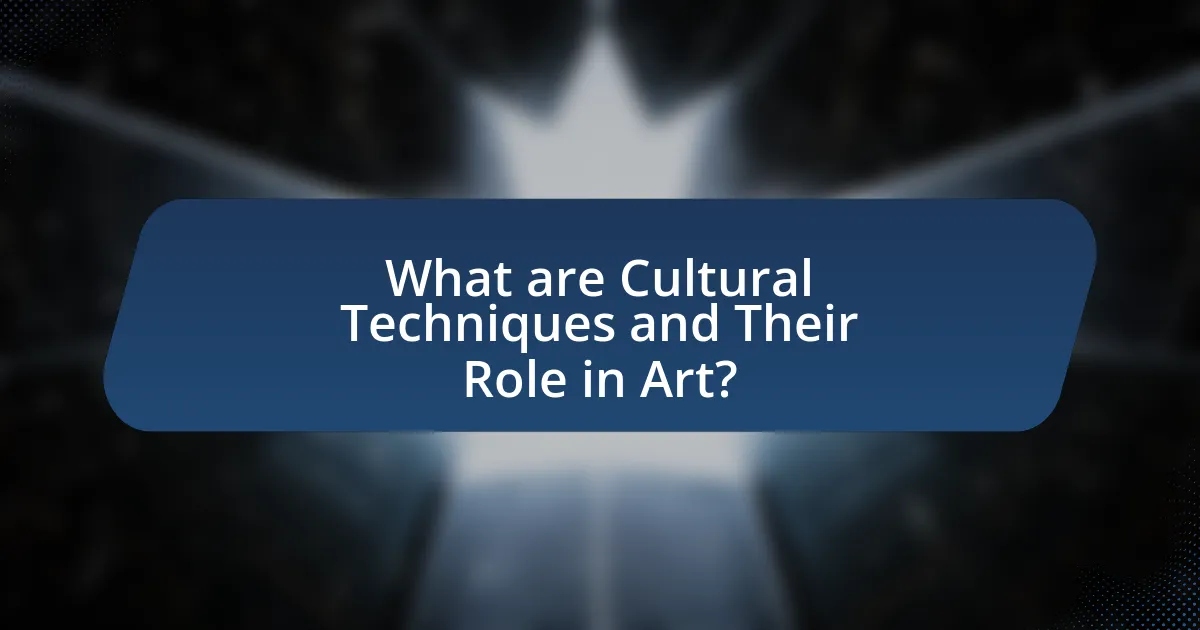
What are Cultural Techniques and Their Role in Art?
Cultural techniques refer to the methods and practices through which societies produce, share, and interpret cultural expressions, including art. These techniques shape the creation and reception of art by influencing the materials, processes, and contexts in which artistic works are developed. For instance, the use of digital technology in contemporary art exemplifies how cultural techniques evolve, allowing artists to engage with audiences in innovative ways. Historical examples include the impact of printmaking techniques during the Renaissance, which democratized art access and transformed artistic production. Thus, cultural techniques play a crucial role in defining artistic practices and facilitating cultural dialogue within and across communities.
How do cultural techniques influence artistic expression?
Cultural techniques significantly influence artistic expression by shaping the methods and materials artists use to convey their ideas. These techniques, which include traditional practices, tools, and societal norms, dictate how art is created and interpreted within different cultural contexts. For instance, the use of indigenous materials and techniques in Native American art reflects cultural values and historical narratives, demonstrating how cultural identity informs artistic choices. Additionally, the integration of technology in contemporary art practices, such as digital media, illustrates how evolving cultural techniques can expand the boundaries of artistic expression, allowing for new forms of engagement and interaction.
What specific cultural techniques have shaped modern art?
Specific cultural techniques that have shaped modern art include abstraction, collage, and performance art. Abstraction emerged in the early 20th century, allowing artists to express emotions and ideas without relying on representational forms, as seen in the works of Wassily Kandinsky and Piet Mondrian. Collage, popularized by artists like Pablo Picasso and Georges Braque, integrated various materials and textures, challenging traditional notions of art and representation. Performance art, which gained prominence in the 1960s with figures like Marina Abramović, emphasized the act of creation itself, blurring the lines between artist and audience. These techniques reflect broader cultural shifts towards individual expression and experimentation, fundamentally altering the landscape of contemporary art.
How do cultural techniques vary across different regions?
Cultural techniques vary significantly across different regions due to historical, social, and environmental factors. For instance, in East Asia, techniques such as ink wash painting and calligraphy emphasize fluidity and harmony, reflecting philosophical traditions like Taoism. In contrast, Western regions often prioritize realism and perspective in painting, influenced by the Renaissance and Enlightenment periods. Additionally, indigenous cultures, such as those in Africa and the Americas, utilize techniques that incorporate local materials and spiritual beliefs, resulting in unique art forms like totem carving and textile weaving. These variations illustrate how cultural context shapes artistic expression and practice, demonstrating the diverse ways in which human creativity manifests globally.
Why is understanding cultural techniques important for modern artists?
Understanding cultural techniques is crucial for modern artists because it enables them to create work that resonates with diverse audiences and reflects contemporary societal issues. By incorporating cultural techniques, artists can draw from a rich tapestry of traditions, symbols, and narratives that enhance the depth and relevance of their art. For instance, artists like Ai Weiwei utilize traditional Chinese art forms to comment on political and social issues, demonstrating how cultural techniques can serve as powerful tools for expression and critique. This understanding not only enriches the artist’s practice but also fosters a dialogue between cultures, promoting inclusivity and awareness in the art world.
How can cultural techniques enhance creativity in art?
Cultural techniques enhance creativity in art by providing diverse frameworks and methodologies that artists can adopt to express their ideas. These techniques, such as traditional crafts, storytelling, and community rituals, offer unique perspectives and practices that can inspire innovative approaches to artistic creation. For instance, the integration of indigenous techniques in contemporary art has led to the emergence of new styles and narratives, as seen in the works of artists like El Anatsui, who incorporates traditional weaving methods into modern sculpture. This blending of cultural practices not only enriches the artistic process but also fosters a deeper connection between the artist and their cultural heritage, ultimately leading to more authentic and varied artistic expressions.
What challenges do artists face when integrating cultural techniques?
Artists face several challenges when integrating cultural techniques, primarily including cultural appropriation concerns, authenticity issues, and the difficulty of mastering diverse techniques. Cultural appropriation can lead to backlash from communities whose traditions are being represented, as seen in cases where artists have faced criticism for using elements from cultures without proper understanding or respect. Authenticity issues arise when artists struggle to balance their personal expression with the cultural significance of the techniques they are incorporating, risking dilution of the original meaning. Additionally, mastering diverse cultural techniques often requires extensive training and understanding, which can be time-consuming and resource-intensive, limiting artists’ ability to effectively integrate these techniques into their work.

How Have Cultural Techniques Evolved in Modern Art Practices?
Cultural techniques in modern art practices have evolved through the integration of technology, globalization, and interdisciplinary approaches. Artists now utilize digital media, such as virtual reality and social media platforms, to create and disseminate their work, expanding the reach and interaction with audiences. For instance, the rise of digital art forms, including NFTs (non-fungible tokens), illustrates how technology has transformed traditional concepts of ownership and value in art. Additionally, globalization has facilitated cross-cultural exchanges, allowing artists to draw inspiration from diverse cultural backgrounds, leading to hybrid art forms that reflect a blend of influences. This evolution is evidenced by the increasing prevalence of collaborative projects that merge various artistic disciplines, such as visual arts, performance, and literature, showcasing a more interconnected and dynamic art landscape.
What historical events have influenced the evolution of cultural techniques in art?
The evolution of cultural techniques in art has been significantly influenced by historical events such as the Renaissance, the Industrial Revolution, and the rise of globalism. The Renaissance, occurring from the 14th to the 17th century, marked a revival of classical learning and values, leading to advancements in perspective, anatomy, and the use of oil paints, which transformed artistic techniques. The Industrial Revolution in the 18th and 19th centuries introduced new materials and technologies, such as photography and mass production, which altered the way art was created and consumed. Additionally, the rise of globalism in the late 20th century facilitated cross-cultural exchanges, allowing artists to incorporate diverse cultural techniques and perspectives into their work, thereby enriching the global art landscape. These events collectively shaped the methodologies and practices within the art world, reflecting broader societal changes.
How did globalization impact the adoption of cultural techniques?
Globalization significantly accelerated the adoption of cultural techniques by facilitating cross-cultural exchanges and collaborations. As countries became more interconnected through trade, technology, and communication, artists and cultural practitioners gained access to diverse cultural practices and techniques from around the world. For instance, the rise of the internet and social media platforms allowed for the rapid dissemination of artistic styles and methods, enabling artists to incorporate elements from various cultures into their work. This blending of techniques has led to the emergence of hybrid art forms, reflecting a globalized cultural landscape. The impact is evident in modern art practices, where influences from African, Asian, and Latin American cultures can be seen in contemporary works, demonstrating how globalization has reshaped artistic expression and technique adoption.
What role do technology and media play in the evolution of these techniques?
Technology and media significantly enhance the evolution of cultural techniques in modern art practices by providing new tools and platforms for creation and dissemination. Digital technologies, such as software for graphic design and video editing, allow artists to experiment with forms and techniques that were previously inaccessible, leading to innovative artistic expressions. For instance, the rise of social media platforms has transformed how art is shared and consumed, enabling artists to reach global audiences instantly and engage with them in real-time. This shift has been documented in studies showing that artists who utilize digital media often experience increased visibility and interaction, which can influence their creative processes and outcomes. Furthermore, advancements in virtual and augmented reality are expanding the boundaries of traditional art forms, allowing for immersive experiences that redefine audience engagement.
How do contemporary artists reinterpret traditional cultural techniques?
Contemporary artists reinterpret traditional cultural techniques by integrating modern themes and technologies into their practices. For instance, artists may use traditional weaving methods while incorporating contemporary materials or digital elements, thus creating a dialogue between past and present. This approach not only preserves cultural heritage but also challenges and expands the meanings associated with these techniques. Evidence of this can be seen in the works of artists like El Anatsui, who utilizes traditional African textile techniques to address contemporary issues such as consumerism and environmental degradation, thereby demonstrating the relevance of traditional methods in today’s context.
What are some examples of modern artworks that utilize traditional techniques?
Examples of modern artworks that utilize traditional techniques include Ai Weiwei’s “Sunflower Seeds,” which employs the ancient Chinese craft of porcelain making, and El Anatsui’s “Earth’s Skin,” which incorporates traditional weaving techniques from West Africa. These artworks demonstrate a fusion of contemporary themes with historical craftsmanship, showcasing the relevance of traditional methods in modern artistic expression. Ai Weiwei’s work features millions of handcrafted porcelain seeds, reflecting on mass production and individuality, while El Anatsui’s use of discarded materials highlights sustainability and cultural heritage.
How do artists balance tradition and innovation in their practices?
Artists balance tradition and innovation in their practices by integrating established techniques with contemporary concepts. This approach allows them to honor cultural heritage while exploring new artistic expressions. For instance, many artists utilize traditional materials or methods, such as oil painting or weaving, but apply modern themes or technologies, like digital media or social commentary, to create a dialogue between the past and present. This synthesis not only preserves cultural identity but also fosters creativity and relevance in a rapidly changing art landscape.
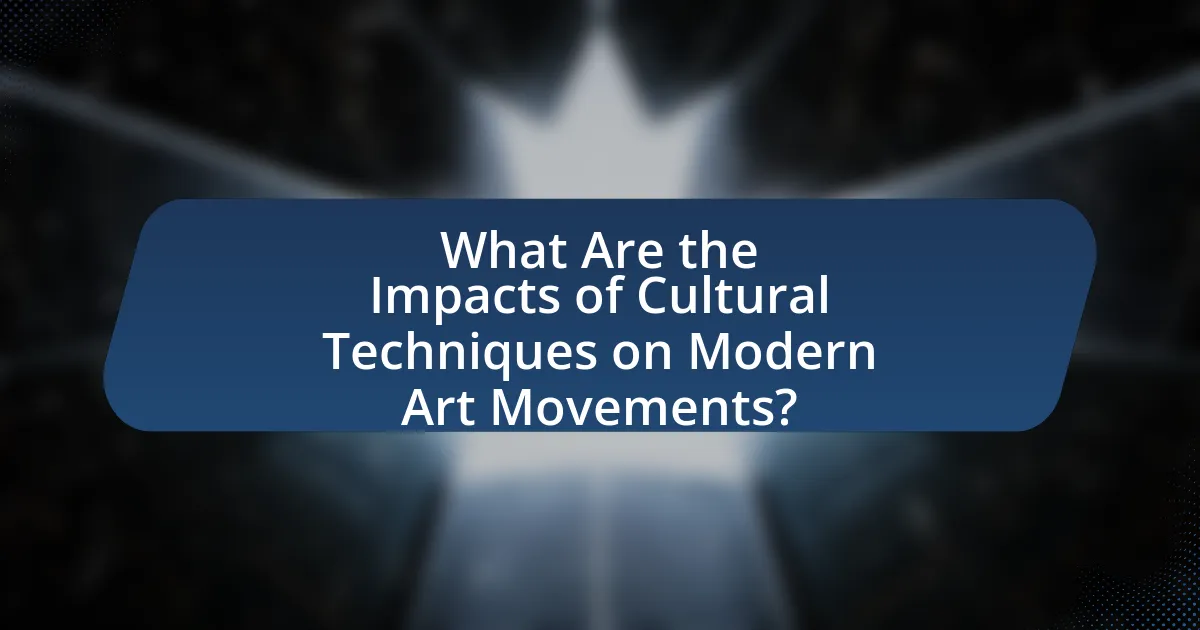
What Are the Impacts of Cultural Techniques on Modern Art Movements?
Cultural techniques significantly impact modern art movements by shaping artistic expression, methods, and audience engagement. These techniques, which include digital media, performance art, and participatory practices, influence how artists create and how audiences interact with art. For instance, the rise of digital technology has led to movements like New Media Art, where artists utilize software and digital platforms to create immersive experiences. This shift has transformed traditional art forms, allowing for greater accessibility and interaction, as seen in the works of artists like Rafael Lozano-Hemmer, who integrates technology into public installations. Furthermore, cultural techniques foster collaboration and community involvement, evident in social practice art, where artists engage with communities to address social issues, exemplified by Theaster Gates’ work in urban revitalization. Thus, cultural techniques are essential in evolving modern art movements, driving innovation and redefining the relationship between art and society.
How do cultural techniques contribute to the identity of modern art movements?
Cultural techniques significantly shape the identity of modern art movements by influencing the methods and materials artists use to express their ideas. For instance, the advent of digital technology has transformed artistic practices, allowing movements like digital art and new media to emerge, which rely on techniques such as coding and digital manipulation. Additionally, cultural techniques such as performance art have redefined the boundaries of art by incorporating elements of theater, dance, and social commentary, as seen in the works of artists like Marina Abramović. These techniques not only reflect societal changes but also challenge traditional notions of art, thereby establishing distinct identities for modern art movements.
What are the key characteristics of art movements influenced by cultural techniques?
Art movements influenced by cultural techniques are characterized by their integration of traditional practices, community engagement, and the use of local materials. These movements often emphasize the importance of cultural identity and heritage, reflecting the values and narratives of specific communities. For example, the Arts and Crafts Movement in the late 19th century sought to revive traditional craftsmanship and promote handmade goods as a reaction against industrialization. Additionally, movements like Afrocentric art incorporate African cultural elements and address social issues, showcasing the influence of cultural techniques on artistic expression. The incorporation of these elements not only enriches the visual language of the artworks but also fosters a deeper connection between the art and its cultural context.
How do cultural techniques foster collaboration among artists from diverse backgrounds?
Cultural techniques foster collaboration among artists from diverse backgrounds by providing shared frameworks and practices that facilitate communication and understanding. These techniques, such as storytelling, traditional crafts, and performance styles, create common ground where artists can exchange ideas and collaborate effectively. For instance, the use of collaborative art forms like mural painting or community-based projects encourages participation from various cultural perspectives, leading to innovative outcomes. Research indicates that such collaborative environments enhance creativity and lead to richer artistic expressions, as seen in projects like the “Art for Social Change” initiative, which successfully brought together artists from different ethnic backgrounds to address social issues through art.
What are the implications of cultural techniques on audience perception of art?
Cultural techniques significantly shape audience perception of art by influencing how artworks are created, presented, and interpreted. These techniques, which include methods of production, distribution, and engagement, affect the context in which art is experienced. For instance, the rise of digital media has transformed traditional art forms, allowing for interactive experiences that engage audiences in new ways, thereby altering their emotional and intellectual responses. Research by media theorist Friedrich Kittler highlights that the medium through which art is conveyed can fundamentally change its meaning and reception, illustrating that cultural techniques are not merely tools but active components in the construction of artistic value and significance.
How do cultural techniques affect the interpretation of modern artworks?
Cultural techniques significantly influence the interpretation of modern artworks by shaping the context in which they are created and viewed. These techniques encompass the methods, practices, and technologies that inform artistic expression and audience engagement. For instance, the use of digital media in contemporary art alters how viewers interact with and understand the work, as seen in the rise of interactive installations that require audience participation. This shift in engagement reflects broader cultural trends towards interactivity and connectivity, which can lead to diverse interpretations based on individual experiences and backgrounds. Additionally, cultural techniques such as globalization and cross-cultural exchanges introduce new perspectives and meanings, as artists draw from various cultural influences, thereby enriching the interpretative landscape of modern art.
What role does cultural context play in the appreciation of art?
Cultural context significantly influences the appreciation of art by shaping the meanings, interpretations, and emotional responses that individuals have toward artistic works. This influence is evident in how cultural backgrounds inform viewers’ perspectives, as art often reflects the values, beliefs, and historical experiences of a society. For instance, the symbolism in African masks can be understood differently by those familiar with the cultural rituals they represent, compared to those without that background. Studies, such as those by anthropologist Alfred Gell, highlight that the appreciation of art is not merely aesthetic but deeply intertwined with cultural narratives and social practices. Thus, cultural context serves as a lens through which art is understood and valued, affecting both individual and collective interpretations.
What best practices can artists adopt when incorporating cultural techniques?
Artists can adopt several best practices when incorporating cultural techniques, including thorough research, respectful engagement, and collaboration with cultural representatives. Thorough research ensures that artists understand the historical and social contexts of the techniques they wish to incorporate, which can prevent misrepresentation and cultural appropriation. Respectful engagement involves acknowledging the origins of these techniques and the communities they come from, fostering a dialogue that honors those traditions. Collaboration with cultural representatives allows artists to gain insights and guidance, ensuring that their work is both authentic and respectful. These practices are supported by the growing emphasis on cultural sensitivity in the art world, as seen in initiatives that promote ethical artistic practices and community involvement.
How can artists ensure respectful representation of cultural techniques?
Artists can ensure respectful representation of cultural techniques by engaging in thorough research and collaboration with the communities from which these techniques originate. This approach fosters understanding and appreciation of the cultural significance behind the techniques, allowing artists to depict them authentically. For instance, artists can consult cultural experts or practitioners to gain insights into the historical context and contemporary relevance of the techniques. Additionally, respecting intellectual property rights and acknowledging the source of inspiration in their work further demonstrates a commitment to ethical representation. This practice aligns with the principles of cultural sensitivity and promotes a more inclusive art landscape.
What resources are available for artists to learn about cultural techniques?
Artists can access various resources to learn about cultural techniques, including online courses, workshops, books, and cultural institutions. Online platforms like Coursera and Skillshare offer courses specifically focused on cultural art practices, while workshops hosted by local art centers provide hands-on experience. Books such as “The Art of Cultural Techniques” by Thomas Y. Levin and “Cultural Techniques: Grids, Filters, Doors, and Other Articulations of the Real” by J. M. B. H. offer in-depth theoretical insights. Additionally, museums and cultural organizations often host exhibitions and lectures that explore the intersection of culture and art, providing artists with valuable knowledge and inspiration.
